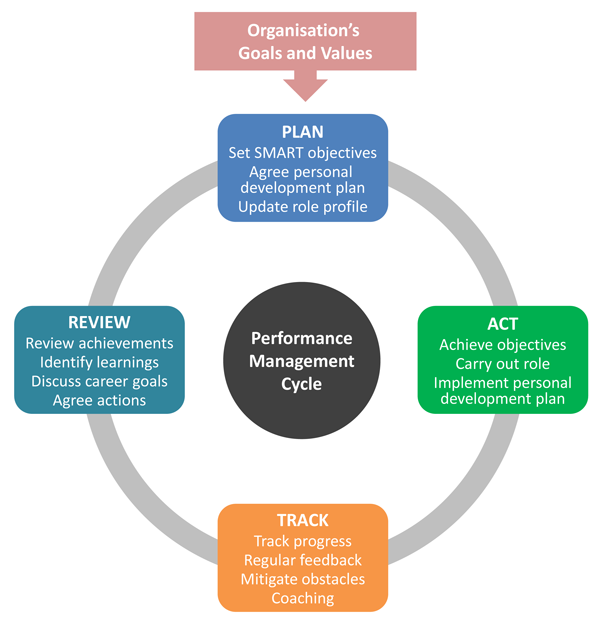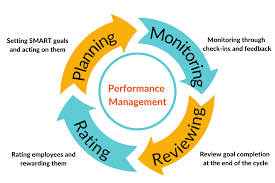Boosting your Manufacturing Performance
Increased demand, volatile raw material prices, new technologies, increased competition, more demanding customers—these all put pressure manufacturing businesses’ performance. Responding quickly to such challenges is key. But can your organization do this? While still keeping employees engaged and motivated?
At EBL, we are used to dealing with such situations. We know where to find the drivers for change in systems, processes, and people. Our approach combines a proven methodological approach with a strong human dynamics aspect—as well as digital, where it matters—to deliver an impact on both performance and people, assuring a long-lasting effect on manufacturing performance.
EBl will help you put better performance management systems in place to achieve this and hold the gains.
What Are the Stages of the Performance Management Cycle?
The first stage of Armstrong’s performance management
cycle is the“Planning” phase for the forthcoming period. Planning
should involve:
Agreeing on SMART objectives
A personal development plan
Actions to be taken in the coming months
A review of the employee’s job requirements, updating the role profile where necessary.
Historically, organisations tended to carry out this planning stage once a year. However, with the business environment becoming increasingly agile and fast-moving, many organisations are adapting their processes to set“near-term”
objectives every three months. The organisation’s goals and values should feed into performance planning to ensure that individualvperformance aligns with the overall strategy of the organisation. Specifically, each SMART objective should contribute to achieving one or more of the organisation’s goals.
Personal development planning, meanwhile, should consider what behaviours, skills or knowledge the individual needs to develop to successfully achieve their objectives and uphold the organisation’s values.


Notice that in the above performance management cycle, there are no arrows between the four stages. This is because, in reality, the stages do not flow one after the other. Act and Track should be continuous throughout the year. Reviews may take place at any point, and planning may take place several times during the year and be re-visited as the needs of the business change

Here is how this Continuous Performance Management process typically looks in leading organisations:
Performance Management Process: The Basic Elements Necessary for Effective Performance Management
There are a few basic elements involved in building an effective performance management framework, including:
Setting Goals
You need to set goals the right way. They need to be meaningful and understood. Employees should have context as to why these individual goals matter and how they are furthering organisational objectives. Employees will care much more about their roles and be much more engaged when they know — and truly understand — how their job matters.
Goal setting is and should be a collaborative process, which involves meeting with employees and being transparent about company goals, direction and obstacles. Armed with this information, employees can create goals which complement organisational objectives and make daily decisions to further these objectives. Furthermore, when employees are put in the driver’s seat and allowed to develop their own goals (before having them approved by their line manager), they experience a heightened sense of autonomy and ownership over their work. Inevitably, this results in improved employee performance.
So What Exactly Is Effective Employee Performance Management?
Having all of the elements of the performance management cycle in place is very important, but this will not necessarily lead to effective performance management for your organisation. There are many other factors in play, such as:
Having buy-in from leadership and senior management to performance management
Ensuring the performance management cycle is continuous and not an annual process
Ensuring performance conversations and reviews are meaningful and not”tick-box” exercises
Implementing easy to use performance management software which supports effective performance management and gives you visibility of performance management activity
The skills and willingness of your managers to deliver effective performance management on a day-to-day basis.
Traditionally, organisations have placed a lot of their emphasis on the“Review” part of the cycle — often because a performance assessment is required for reward purposes. However, we have always advised that it is the“Act” and“Track” stages that are the most important. These stages are where performance is actually delivered and results achieved. Individuals need to be encouraged to schedule in regular time to work on achieving their objectives and personal development plans.
Similarly, managers need to be checking in with their staff regularly. They must give frequent, effective feedback and use coaching skills to help their team members overcome challenges and identify opportunities for learning and performance improvement. If this is left until an end-of-year review, it is too late — objectives and development plans may end up only partially achieved.
What Does the New Continuous Performance Management Cycle Look Like?
Since 2015, this philosophy of continuous performance management has been adopted by leading organisations such as Deloitte, Adobe and General Electric. All these major names have ditched the traditional once-a-year performance appraisals in favour of regular”check-ins” and frequent (or real-time) feedback.
These regular performance discussions are typically developmental and future-focused. They provide team members with an opportunity throughout the year to explore what has gone well and how success can be replicated, any challenges faced and how they may be overcome — and to agree on actions both the individual and manager need to take to develop the individual and further improve their performance. Such check-ins are also a great opportunity to address employee development while offering training opportunities and regularly reinforcing performance expectations.
Transparent Communication and Collaboration
Employees want — and deserve — their managers and leaders to be open and authentic at all times. They don’t want to be kept in the dark when their companies are going through hard times, especially in the midst of a COVID-19 pandemic. They want to be kept abreast of pertinent information. On top of this, they want real-time communication while building healthy relationships with their colleagues and managers. This will involve regular feedback and honest discussion — even when such communication is difficult or uncomfortable.
Employee Recognition
An effective performance management system should prioritise employee recognition and reward. Employees should feel valued and appreciated for the work they do and the effort they put in. If employee recognition is not a priority, this will most likely have a negative bearing on your voluntary turnover.
Honest and regular feedback and reviews are needed — the more frequent and precise the feedback, the better individual performance. It’s that simple. Employees want regular insights into their work, and the better-informed employees are regarding their performance, the better able they are to improve and excel.
Employee Development
No ambitious top performer wants to remain at a company long-term without honing and developing skills. Advancement and development are important to employees — not to mention, companies stand to benefit when employees are more skilled and capable.
Here for you
Call us 24/7. We are there for your support
GPS Address
AK - 040-4605
Contact Details
Email Address: [email protected] +233200642591 +233202473696
Where to find us
119 Otumfo Osei Tutu II
Adjacent SSNIT Buidling
Kumasi - Ashanti Region
Ghana, West Africa
